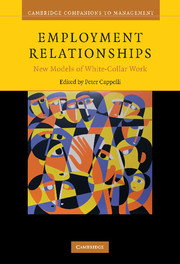Book contents
- Frontmatter
- Contents
- List of figures
- List of tables
- List of contributors
- Foreword
- 1 Introduction
- 2 Corporate restructuring and the employment relationship
- 3 The up and out in organizations
- 4 In the pursuit of quality and quantity: the competing demands in call centers
- 5 Three's a crowd? Understanding triadic employment relationships
- 6 The changed world of large law firms and their lawyers: an opportune context for organizational researchers
- 7 The upside of bureaucracy: unintended benefits for professional careers
- Index
- References
6 - The changed world of large law firms and their lawyers: an opportune context for organizational researchers
Published online by Cambridge University Press: 02 December 2009
- Frontmatter
- Contents
- List of figures
- List of tables
- List of contributors
- Foreword
- 1 Introduction
- 2 Corporate restructuring and the employment relationship
- 3 The up and out in organizations
- 4 In the pursuit of quality and quantity: the competing demands in call centers
- 5 Three's a crowd? Understanding triadic employment relationships
- 6 The changed world of large law firms and their lawyers: an opportune context for organizational researchers
- 7 The upside of bureaucracy: unintended benefits for professional careers
- Index
- References
Summary
He had graduated from Harvard Law School in the early 1970s and had gone to the New York office of a large US law firm, where he had made it up to partner and stayed his entire career. Now he was thinking about retiring. In looking back, he didn't quite know what to think about the firm and how it had changed. Its sheer size, wealth, and geographical expanse had made it different from before even though it had grown gradually and maintained its standing among its rivals. Its lean hierarchy was something of the past as well. While once there had been just partners and associates on the “up to partner or out of the firm” system, now there were a variety of tiers of lawyers, who were managed differently and, as a result, felt differently about the firm. In addition, the firm had gone from developing its own talent with some exceptions to accepting the fact that it had to acquire partners laterally from other firms, a varied lot of real stars, ambitious types from lesser firms, specialists in hot areas, and others who turned out to be just hot air. The firm had varying degrees of success with these talent acquisitions.
The above partner is a microcosm of the changed world of large law firms and their lawyers in the past thirty years.
- Type
- Chapter
- Information
- Employment RelationshipsNew Models of White-Collar Work, pp. 179 - 222Publisher: Cambridge University PressPrint publication year: 2008
References
- 3
- Cited by



